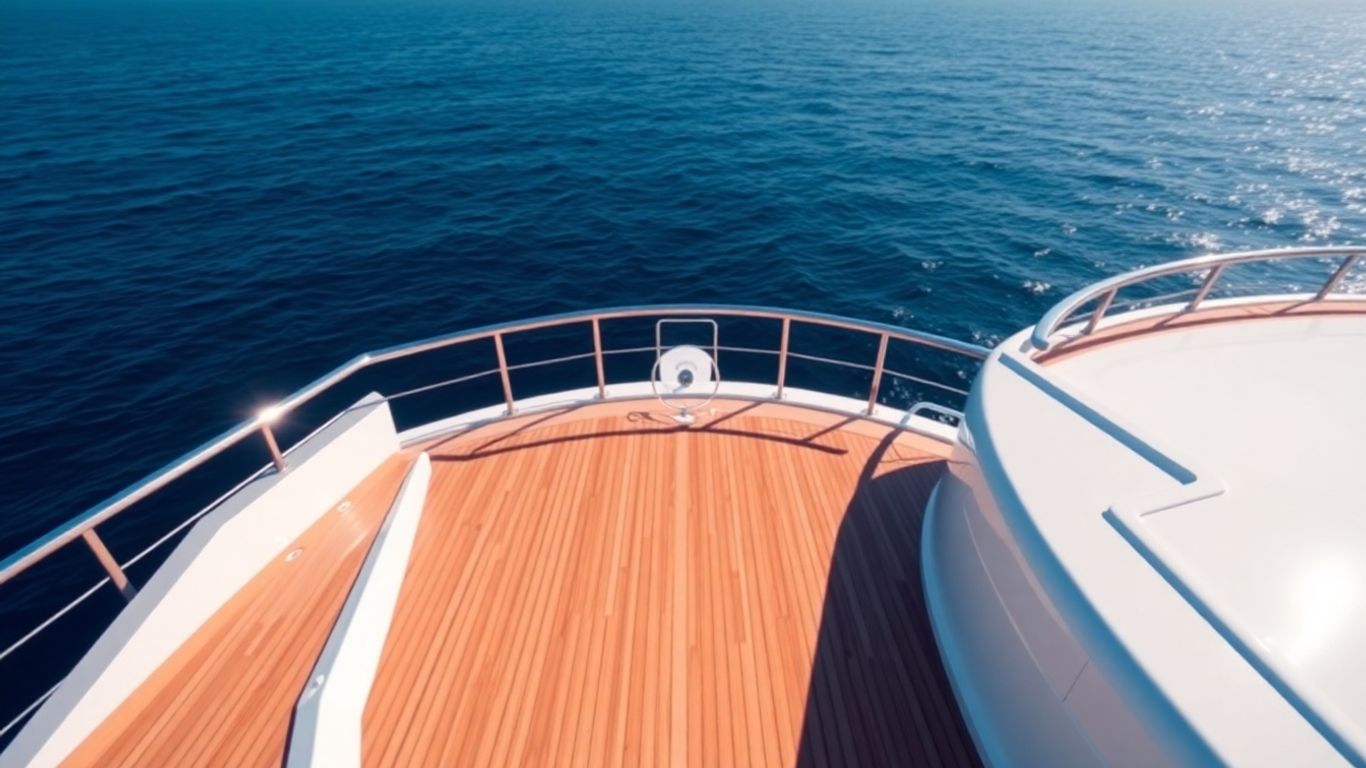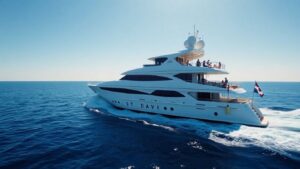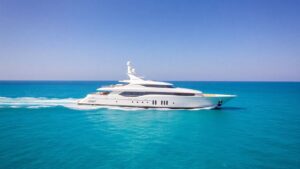Ever wondered what makes a yacht tick, from the very front all the way to the back? It’s more than just a pretty boat. The whole layout, from the strong hull that keeps it steady to the fancy rooms inside, is put together with a lot of thought. We’re going to break down how all these parts work together to create that amazing experience you see on the water. It’s all about smart design and making sure everything functions well.
Key Takeaways
- The hull is the main part of the boat that keeps it stable in the water and affects how it moves.
- The deck layout is planned carefully to make it easy to move around and use the boat for different things.
- Inside the yacht, spaces are designed to be comfortable and feel luxurious, like the main living area and bedrooms.
- Modern technology is used for steering and knowing where the boat is, making trips safer and easier.
- Engines provide the power for motor yachts, and how they connect to the propellers is key for performance.
Understanding The Hull: Foundation Of Stability
When you think about a yacht, the hull is really the main part, isn’t it? It’s what sits in the water and basically dictates everything about how the boat behaves. It’s not just about how it looks, though that’s part of it. The hull’s shape and size have a huge impact on how stable the yacht is, how efficiently it moves through the water, and even how safe it feels when the waves pick up. Think of it as the boat’s skeleton and skin all rolled into one. Getting the hull right is the first big step in building a good yacht.
Unveiling The Core Of Stability And Design
The hull is where the magic starts, really. It’s the part that keeps the yacht afloat and upright. The way it’s designed affects how much it rocks side-to-side (that’s called roll) and how it pitches forward and backward (that’s pitch). A wider hull generally means more initial stability, making it feel more solid when you’re just sitting still or moving slowly. But then you have to think about how it moves at speed. Different hull shapes are built for different jobs. Some are made to cut through the water smoothly, while others are designed to lift up and skim over the surface.
- Displacement Hulls: These are like the workhorses. They push through the water, displacing it as they go. They’re usually found on bigger, slower cruising yachts because they offer great stability and can carry a lot of weight. They’re not built for speed, though.
- Planing Hulls: These are the speed demons. They have flatter bottoms that allow the yacht to lift out of the water and ride on top at higher speeds. You see these a lot on powerboats and faster motor yachts. They’re less stable when stopped but gain stability as they pick up speed.
- Multihull Designs: Think catamarans or trimarans. These have two or more hulls. They offer a lot of deck space and are very stable, but they can be a bit more complex to handle and might create more drag.
The shape of the hull is a careful balancing act. Designers have to consider how the water flows around it, which they call hydrodynamics. This flow affects how much drag the boat creates, how much lift it gets, and how stable it remains in different conditions. It’s all about making the water work for the boat, not against it.
The Hull's Role In Yacht Performance
So, how does the hull actually affect how the yacht performs? Well, it’s pretty significant. The hull shape influences the boat’s speed, how much fuel it uses, and how well it handles rough seas. A hull that’s designed to reduce drag will make the yacht faster and more fuel-efficient. Similarly, a hull that generates lift can help the boat plane more easily. The way the hull interacts with waves also plays a big part in how comfortable the ride is. You want a hull that cuts through waves nicely, rather than slamming into them. Getting the weight distribution right within the hull is also super important for balance and control. If too much weight is at the front, the bow can dig in; too much at the back, and the stern can squat. It’s all about finding that sweet spot for optimal hull performance.
Hull Design Variations For Different Yachts
Not all yachts are the same, and neither are their hulls. The intended use of the yacht really drives the hull design. For instance, a long-distance cruising yacht will have a different hull than a sporty day cruiser. Here’s a quick look at some common variations:
- Round-bilge hulls: These have a smooth, rounded shape where the sides meet the bottom. They’re known for a comfortable ride and good maneuverability, often found on displacement or semi-displacement yachts.
- Chine hulls: These have sharper angles, or chines, along the hull. They can provide more stability at rest and help lift the boat onto a plane, often seen on faster powerboats.
- Deep-V hulls: These have a pronounced V-shape along the bottom. They cut through waves very effectively, offering a smoother ride in choppy conditions, but can be less stable at slow speeds.
Each of these designs has its own trade-offs. A naval architect has to weigh these carefully to create a hull that matches the yacht’s purpose, whether it’s for leisurely cruising, high-speed travel, or even racing. The materials used also matter, affecting weight, strength, and cost. It’s a complex puzzle, but getting the hull right is the first piece.
Deck Layout: Functionality And Design
The deck of a yacht is really where the action happens, isn’t it? It’s the main stage for everything from working the boat to just kicking back and enjoying the view. Think of it as the yacht’s exterior living room and workspace all rolled into one. How it’s set up makes a huge difference in how you use the boat.
Unveiling The Core Of Stability And Design
The Hull's Role In Yacht Performance
Hull Design Variations For Different Yachts
Strategic Layouts for Optimal Functionality
The deck layout is all about making things work smoothly. It’s not just about looking good; it’s about making sure you can move around easily and get things done without tripping over yourself. This means thinking about where people will walk, where lines will be handled, and how you get to the helm. A well-planned deck makes life on board much simpler.
Balancing Operational Needs and Aesthetics
It’s a constant balancing act, really. You want the yacht to look sleek and impressive, but it also needs to be practical. For instance, the helm station needs great visibility so the captain can see everything, but it also needs to fit into the overall look of the boat. Sometimes, features that are great for working the boat, like easy access to winches or cleats, might not be the most visually appealing, so designers have to find clever ways to integrate them.
Ensuring Seamless Movement from Bow to Stern
Getting from the front of the boat (the bow) to the back (the stern) should be a breeze. Good design means clear pathways. You don’t want to be squeezing past furniture or equipment just to get from one end to the other. This is especially important when the yacht is moving or if you’re handling lines. Think about how you’d move around your own house – you want clear hallways, not obstacles.
Here’s a quick look at some common deck areas and their purpose:
- Foredeck: Often features sunpads for lounging, but also houses anchor handling equipment. It needs to be sturdy and safe for this work.
- Aft Deck: This is usually a social area, with seating and tables. It might also include access to the swim platform.
- Side Decks: These are the walkways that go around the boat. They need to be wide enough for safe passage, especially in rougher weather.
- Flybridge: On larger yachts, this upper deck offers commanding views and often includes a secondary helm station, seating, and entertainment areas.
The way deck spaces are arranged can really change how you feel on the yacht. An open layout can make a smaller boat feel bigger, while clever use of multi-functional furniture means you can adapt spaces for different activities, like dining or just relaxing.
Interior Spaces: Comfort And Luxury
Unveiling The Essence Of Interior Spaces
When you step inside a yacht, it’s like entering a whole different world. Forget the rocking waves for a moment; the inside is all about making you feel right at home, but, you know, way more fancy. Designers really put a lot of thought into how everything fits together, making sure it’s not just pretty to look at but also works well for living on the water. It’s this blend of practical living and high-end style that truly defines a yacht’s interior. They use nice materials, like polished wood and soft fabrics, and make sure there’s enough light, often with big windows or skylights, so it doesn’t feel cramped. It’s all about creating a personal retreat, whether you’re out at sea or docked somewhere interesting.
The Main Salon As The Heart Of The Yacht
The main salon is pretty much the living room of the yacht, and it’s usually the biggest space. This is where everyone hangs out, eats, and just generally relaxes. Designers try to make it feel open and airy, even though it’s inside. They often use a color palette that’s calming and maybe echoes the blues and whites of the sea. Sometimes, you’ll find clever furniture that can be moved around or changed, like tables that go up and down, so you can use the space for different things throughout the day. It’s the central hub, connecting the different parts of the yacht and giving everyone a comfortable place to gather.
Here’s a look at what you might find in a typical main salon:
- Seating Areas: Plenty of comfy sofas and chairs, often arranged for conversation.
- Dining Space: A table that can accommodate guests for meals.
- Entertainment: Sometimes there’s a TV or sound system tucked away.
- Bar Area: Many larger yachts have a small bar for drinks.
The goal is to make this space feel both grand and welcoming, a place where you can truly unwind and enjoy the experience of being on the water.
Designing Restful Sleeping Quarters
After a day out on the water, getting a good night’s sleep is important. The cabins, or staterooms, are designed to be peaceful sanctuaries. They’re usually more private than the main salon, and the focus is on comfort and making the most of the space. You’ll find well-made beds, plenty of storage for clothes and personal items, and often an en-suite bathroom. Even in smaller cabins, designers use smart tricks like built-in storage and mirrors to make the room feel bigger and more functional. It’s about creating a private space where you can recharge for the next day’s adventures.
Navigation And Electronics: Technological Mastery
When you’re out on the water, knowing where you are and what’s around you is pretty important, right? That’s where a yacht’s navigation and electronics come into play. It’s a mix of old-school seamanship and some really fancy tech that keeps you on course and out of trouble. Think of it as the yacht’s brain and eyes.
Integrating Advanced Navigation Systems
Modern yachts are packed with systems that help you figure out your position and plot a course. You’ve got your GPS, which is basically a super-accurate map that knows exactly where you are at all times. Then there’s radar, which is like a bat’s sonar but for boats – it bounces signals off things to show you other vessels, land, or even big waves, especially when visibility is low. Depth sounders, or sonar, are also key; they tell you how deep the water is beneath the hull, which is vital for avoiding shallow spots or underwater obstacles. All this information usually gets displayed on screens that can show charts, radar overlays, and other data all at once.
- Global Positioning System (GPS): Pinpoints your exact location using satellites.
- Radar: Detects objects and other vessels by sending out radio waves.
- Depth Sounder/Sonar: Measures the distance to the seabed.
- Autopilot: Can steer the yacht along a pre-set course, freeing up the crew.
The Role Of Helm Stations In Yacht Control
The helm station is where the captain and crew actually steer the yacht. It’s not just a steering wheel anymore. You’ll find a whole array of screens and controls here, all designed to give you easy access to the navigation and communication systems. The layout is usually pretty thoughtful, putting the most important controls within easy reach. This is the command center, where decisions are made and executed. Whether it’s a sleek flybridge helm with panoramic views or a more enclosed pilothouse station, its design is all about giving the person in charge clear visibility and control over the vessel’s movement.
Enhancing The Yachting Experience With Technology
Beyond just getting from point A to point B safely, electronics on a yacht can really make the journey more enjoyable. Think about communication systems like VHF radios for talking to other boats or shore stations, and satellite phones for when you’re really out there. Many yachts also have integrated entertainment systems, Wi-Fi, and even systems that let you monitor things like engine performance or tank levels right from a tablet. It’s all about making life on board more comfortable and connected.
Modern yacht electronics are designed to be user-friendly, consolidating complex information onto intuitive displays. This allows for better situational awareness and easier operation, even for those who aren’t tech wizards. The goal is to make sailing or cruising as stress-free and enjoyable as possible, letting you focus on the scenery and the experience.
Here’s a quick look at some common electronic systems:
- VHF Radio: For short-range communication with other vessels and shore stations.
- AIS (Automatic Identification System): Transmits and receives information about other vessels, like their name, speed, and course.
- Satellite Communications: For long-range communication and internet access.
- Entertainment Systems: Including audio and visual equipment for onboard enjoyment.
Propulsion Systems: Power And Performance

When you think about what makes a yacht move, the propulsion system is the real workhorse. Unlike sails that catch the wind, the engine provides a steady push, letting you cover serious ground whether you’re out on the big ocean or just cruising into a harbor. It’s all about getting you where you want to go, reliably.
Direct Propulsion For Motor Yachts
For motor yachts, the engine is everything. The whole point is to have that power readily available. Modern engines are pretty amazing, packing a punch while also trying to be easier on fuel and the environment. They’re designed to give you speed and control, making sure your trip is as smooth as possible. The connection between the engine and the propeller is super important; it’s what actually pushes the water and moves the boat. Getting this right means the engine can do its job without being overworked, and the boat moves efficiently.
Modern Engine Technology And Efficiency
Engine makers are always tweaking things to get more power out of less fuel and to cut down on pollution. You’ll find all sorts of clever tech in today’s yacht engines, from advanced fuel injection to better ways of managing exhaust. This means you can go further on a tank of gas and feel a bit better about your impact on the water. It’s a constant balancing act between raw power and being smart about resources.
The Crucial Engine-Propeller Connection
The way the engine connects to the propeller is a big deal for how the yacht performs. This setup, often called the drivetrain, includes things like shafts and the propeller itself. The size and shape of the propeller, and how it’s geared to the engine, directly affect how much thrust the boat gets and how fast it can go. Getting this combination just right means the engine operates in its sweet spot, giving you the best speed and efficiency for the hull’s design. It’s a bit like matching the right shoes to your running style – it makes a big difference in how well you perform.
- Engine Placement: Where the engine sits affects the boat’s balance and how it handles. Usually, they’re placed centrally or towards the back.
- Shaft Angle: The angle of the shaft connecting the engine to the propeller matters for efficiency and reducing vibration.
- Propeller Choice: The diameter and pitch of the propeller need to be matched to the engine’s power and the boat’s hull shape.
The goal is to make the engine and propeller work together perfectly, so the yacht moves through the water with as little fuss as possible. It’s all about making sure the power gets to the water in the most effective way.
Sails And Rigging: Harnessing The Wind

When you think about a yacht, especially a sailboat, the sails and rigging are what really make it go. It’s all about catching the wind and turning that into forward motion. The rigging itself is a whole system of masts, ropes, and, of course, the sails. Getting it all set up right is pretty important for how the boat performs.
Translating Wind Energy Into Movement
The way sails and rigging are designed makes a big difference in how fast a yacht can go, how it handles, and just how useful it is. A good rigging setup helps the yacht perform better, whether you’re just cruising along the coast or out on the open water. It also helps keep the boat steady, which is a big deal when the weather gets rough.
- Mainsail: This is usually the biggest sail, attached to the main mast. It’s the primary power source, catching the wind to push the yacht. Its size and shape really affect how much wind it can grab, which in turn influences speed and how the boat steers.
- Jib: This is a triangular sail you’ll find at the front of the boat, near the bow. It works together with the mainsail to make the airflow over the sails more efficient.
- Genoa: A larger version of the jib, often overlapping the mainsail, providing more power in lighter winds.
The Impact Of Sail And Rigging Design
It’s not just about having sails; it’s about how they’re designed and how the rigging supports them. The materials used, the shape of the sails, and how all the lines (ropes) are run to the winches all play a part. A well-thought-out sail plan can make a huge difference in a yacht’s capabilities.
The whole setup needs to work together. You’ve got the mast holding everything up, the sails catching the wind, and all the lines to adjust them. It’s a bit like a complex dance, and when it’s done right, the boat just glides.
Key Sails For Yacht Propulsion
Different sails are used for different conditions. Knowing which sail to use and when is part of the skill involved in sailing.
| Sail Type | Primary Use |
|---|---|
| Mainsail | Primary power sail, attached to the main mast |
| Jib | Forward sail, helps with balance and speed |
| Spinnaker | Large, lightweight sail for downwind sailing |
| Storm Jib | Small, heavy-duty sail for high winds |
Bringing It All Together
So, as we’ve seen, a yacht is way more than just a pretty boat. From the pointy end at the bow all the way back to the stern, every single piece has a job to do. The hull keeps it floating, the decks are where everything happens, and all the systems, from the engines to the little fittings, have to work together. It’s a lot to think about, really. Designing one of these things is a huge puzzle, making sure it looks good but also works right and is safe. It’s pretty cool when you realize how much goes into making a yacht ready for a trip out on the water.
Frequently Asked Questions
What is the hull of a yacht and why is it important?
The hull is the main body of the yacht that sits in the water. Think of it as the boat’s foundation. It’s super important because it keeps the yacht stable and helps it move through the water smoothly. Different hull shapes are used for different types of yachts, affecting how well they sail.
How does the deck layout help a yacht work better?
The deck is like the yacht’s main floor. Its layout is planned carefully so people can move around easily and do different jobs, like steering or handling ropes. A good deck plan makes sure everything is in the right place, making the yacht easier and more enjoyable to use.
What makes the inside of a yacht feel comfortable and fancy?
The inside of a yacht is designed to be a comfy and luxurious place. The main living area, called the salon, is usually the central spot for relaxing and spending time. Sleeping areas are also made to be cozy and private, using nice materials to make everything feel special.
What kind of technology helps a yacht navigate?
Yachts use advanced technology for navigation, like GPS and radar, to figure out where they are and steer safely. The steering wheel and control area, called the helm station, is where the captain uses these tools to guide the yacht.
How do yachts move through the water?
Most motor yachts move using engines that turn propellers, which push the boat through the water. These engines are designed to be powerful and efficient. The connection between the engine and the propeller is key to making the yacht go.
What do sails and rigging do on a yacht?
On sailboats, sails and rigging are what catch the wind to make the yacht move. The rigging includes the mast, ropes, and sails themselves. The shape and size of the sails are important for how fast and well the yacht sails, and the crew uses them to steer.



